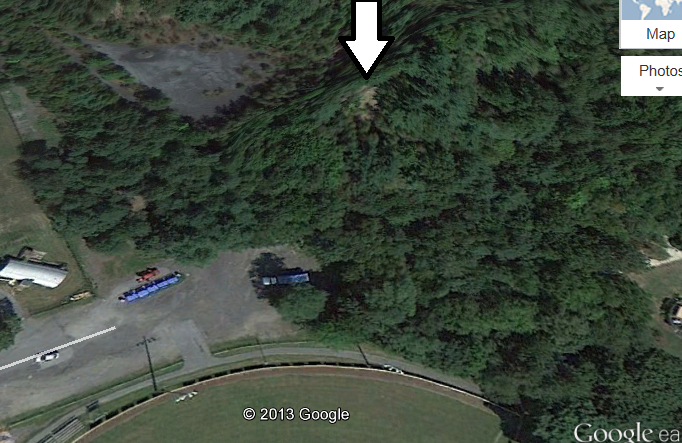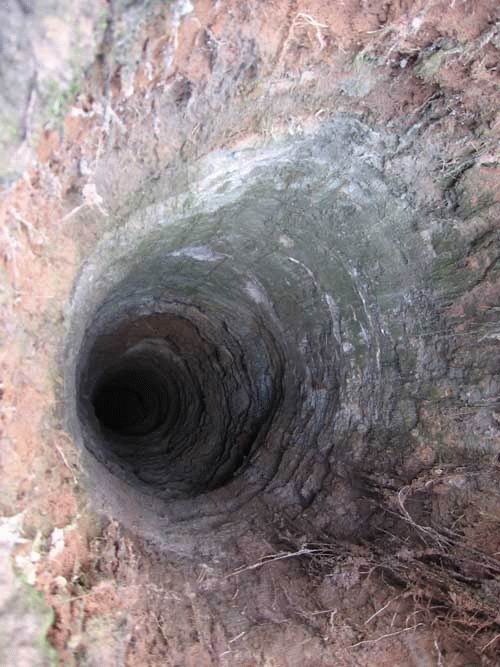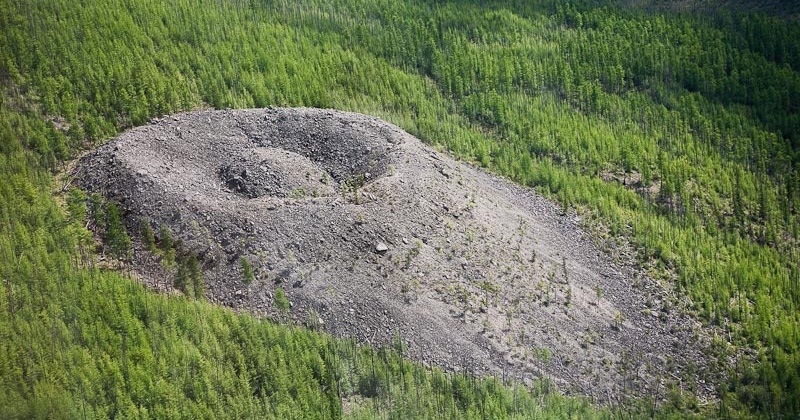It looks like you're using an Ad Blocker.
Please white-list or disable AboveTopSecret.com in your ad-blocking tool.
Thank you.
Some features of ATS will be disabled while you continue to use an ad-blocker.
share:
Tsu322
reply to post by OpenMindedRealist
There are a lot of slag heaps where I live and I see them every day on the way to work. The heaps here are from coal mines and a lot darker than the heap in the pics but it looks like the exact same shape but bigger.
I looked for any photos that show them from the top, I know the gravel works here has a pipe that drops the gravel from the top and looking down on the mound there is a hole with a small mound in the center. I think we can rule out slag heap because there would be many other signs of mining, considering this is not that old.
reply to post by Char-Lee
I'm not saying it is definitely a mine, I'm really not sure what it is but in this pic there seems to be something like a road going around the heap.
I am sure it is mad made somehow, tunneling, mining, that sort of thing.
freestonew
reply to post by freestonew
they say no work camps are anywhere nearby. no mines either.
freestone
I'm not saying it is definitely a mine, I'm really not sure what it is but in this pic there seems to be something like a road going around the heap.
I am sure it is mad made somehow, tunneling, mining, that sort of thing.
Ive seen similar shapes while cleaning brass in a Lyman brass tumbler. and it kind of reminds me of the Mima mounds found around North America. Im
wondering if some kind of seismic activity may have caused the mound but curious that there is ony one.
reply to post by rickymouse
I believe that some Siberian tribes thought that mammoths were burrowing creatures which died on exposure to air ..... Could this be a mammoth hill (like a mole hill, but bigger)?
I believe that some Siberian tribes thought that mammoths were burrowing creatures which died on exposure to air ..... Could this be a mammoth hill (like a mole hill, but bigger)?
AndyMayhew
reply to post by rickymouse
I believe that some Siberian tribes thought that mammoths were burrowing creatures which died on exposure to air ..... Could this be a mammoth hill (like a mole hill, but bigger)?
Interesting I wonder why they would think that. Tribal people seem very observant of nature, maybe there was a similar looking animal that lived underground.
Char-Lee
AndyMayhew
reply to post by rickymouse
I believe that some Siberian tribes thought that mammoths were burrowing creatures which died on exposure to air ..... Could this be a mammoth hill (like a mole hill, but bigger)?
Interesting I wonder why they would think that. Tribal people seem very observant of nature, maybe there was a similar looking animal that lived underground.
I believe it was because they occasionally came across remains eroding out of the permafrost, but never saw any live animals. So a natural assumption for a curious but primitive people. I don't think anyone today thinks woolly mammoths lived underground
I am leaning towards a dried up geyser. A giant water jet that erupted fiercely, stopped for a while, and then erupted again with less intensity,
could have made this mound of "gravel".
The ejected material is laying in a perfectly natural slope, as if it were dumped there from above, rather then being heaved up. It seems at the material went airborne and landed around what is now a cone shape, and the material formed natural slope angles, tumbling until it matched a stable angle where it stopped rolling. Naturally, it went further down the fall-line side of the cone, helped by gravity. On the bottom of the donwnhill edge, you can see where the larger debris rolled down to the bottom edge instead of stopping mid-slope. This left a fairly smooth and "silty" looking downhill face where the water deposited the lighter silts.
To support this theory of construction, you can see some vegitation growing on the "silt patch" area of the mound. Silt would naturally hold more moisture than the rubble, and support regrowth.
www4.ncsu.edu...
The ejected material is laying in a perfectly natural slope, as if it were dumped there from above, rather then being heaved up. It seems at the material went airborne and landed around what is now a cone shape, and the material formed natural slope angles, tumbling until it matched a stable angle where it stopped rolling. Naturally, it went further down the fall-line side of the cone, helped by gravity. On the bottom of the donwnhill edge, you can see where the larger debris rolled down to the bottom edge instead of stopping mid-slope. This left a fairly smooth and "silty" looking downhill face where the water deposited the lighter silts.
To support this theory of construction, you can see some vegitation growing on the "silt patch" area of the mound. Silt would naturally hold more moisture than the rubble, and support regrowth.
www4.ncsu.edu...
edit on
13-11-2013 by zayonara because: (no reason given)
You know in hindsight there was a place where I spent some of my childhood that had a very similar look to it. We called it the mound and it was at
the top front side of a mountain. All around the mound was trees and forest stuff but the mound was bare.
I wonder if I can find it on Google earth?
I wonder if I can find it on Google earth?
edit on 13-11-2013 by Rosinitiate because: (no reason given)
reply to post by Char-Lee
How about the reports of the odd, circular bore holes located in remote areas in Russia/Siberia? What struck me about those reports was the lack of excavated material. Where did it go? Is it possible it was transported here by helicopter and dumped?
Mystery Holes in Russia
How about the reports of the odd, circular bore holes located in remote areas in Russia/Siberia? What struck me about those reports was the lack of excavated material. Where did it go? Is it possible it was transported here by helicopter and dumped?
Mystery Holes in Russia
reply to post by Tsu322
I don't see any road. The people who have traveled there certainly didn't use any roads, take a look at the place, it is way out there.
What type of mining could make such a huge mound without heavy equipment? Where would they have brought the material from? Any heavy equipment work should still be able to be seen and they would not haul any of the stuff back out, it would still be there. They also say this is from the 1840's.
englishrussia.com...
I'm not saying it is definitely a mine, I'm really not sure what it is but in this pic there seems to be something like a road going around the heap.
I am sure it is mad made somehow, tunneling, mining, that sort of thing.
I don't see any road. The people who have traveled there certainly didn't use any roads, take a look at the place, it is way out there.
What type of mining could make such a huge mound without heavy equipment? Where would they have brought the material from? Any heavy equipment work should still be able to be seen and they would not haul any of the stuff back out, it would still be there. They also say this is from the 1840's.
englishrussia.com...
Sadly, the image doesn't do it justice and appears that trees are now growing there....odd.


zayonara
I am leaning towards a dried up geyser. A giant water jet that erupted fiercely, stopped for a while, and then erupted again with less intensity, could have made this mound of "gravel".
www4.ncsu.edu...edit on 13-11-2013 by zayonara because: (no reason given)
I don't see gravel I see boulders and various shape cut large pieces of rock. Geysers generally leave an open hole unless limestone or other water soluble material erodes and fills the hole.
jtma508
reply to post by Char-Lee
How about the reports of the odd, circular bore holes located in remote areas in Russia/Siberia? What struck me about those reports was the lack of excavated material. Where did it go? Is it possible it was transported here by helicopter and dumped?
Mystery Holes in Russia
So many mysterious things! There are also the mystery holes appearing...maybe something does live down there!There are no vehicle tracks no drilling signs, it is like the place in Russia where the people saw a huge piece of earth weighing many tons disappear overnight, it was in boggy ground left sharp edges, went down I believe it was 12 ft deep by 12 ft long and the whole piece of ground was simply gone. (haven't been able to find the story)
From the end of 1980s a strange phenomena is happening in some Russian forests. People find strange, deep holes.
They appear in the dense forest, in the places you can’t get on the car or truck to bring any device to drill the ground. There is no any soil that should be taken from such deep holes is found.
On this pictures people go down to one of such holes but it just finishes with nothing. There are no any reasonable ideas on how these holes appear and what they are being used for.

edit on 13-11-2013 by Char-Lee because: (no reason given)
For my twopence worth. This looks like a Howe i.e. a neolithic round barrow.
We have a few in East Yorkshire e.g. Duggleby Howe or Willy Howe.
The size and shape seem about right but the top is very unusual.
We have a few in East Yorkshire e.g. Duggleby Howe or Willy Howe.
The size and shape seem about right but the top is very unusual.
11andrew34
This area was covered by glaciers during the previous ice age, which makes it likely to be a glacial landform of some sort. And obviously, it wasn't there before the previous ice-age, or at least, the rock pile wasn't. Perhaps the depression is an old meteorite crater? But even that wouldn't have been necessary to explain it.
As the glacier melted, streams formed, some of them short lived. A short lived stream may have transported and deposited rocks in this pattern, perhaps off a small waterfall coming off a glacier, say a ~20ft wall of ice just above it. You can see the formation is not perfectly circular; it's oriented with the slope. Larger/heavier rocks piled up in the middle where the water fell. Smaller rocks scattered radially, pushed from that center by the water flow. That's the easy part to guess.
This location is relatively close to the source of the alpine glacier. It would have begun to form at the end of the life of the glacier. So here's my guess at how the cone formed:
The formation began at the base of a waterfall off the ice wall of a glacier. The base level of this formation formed first. The heaviest rocks remained in the center where they fell, and smaller rocks were pushed from the center into a ring. As the glacier melted, the ice wall retreated, and so the place where the water fall hit the ground traveled uphill over time. Also, as the glacier was in its last years, the average flow rate decreased from year to year, and the drop of the falls became shorter. With less water flowing and less far to drop, the energy to scatter rocks is gradually decreasing. Thus the radius of the ring becomes shorter over time, as the center point travels uphill, explaining the cone shape, and smaller rocks can increasingly remain in the center instead of being scattered out to the ring wall. The final central rock pile is the final landing spot for the waterfall that created this formation.
One thing I'd add though is that the rock pile is supposedly all limestone. Limestone is very susceptible to weathering. I'm not sure if it's unusual for a pile of limestone to have lasted so long there. This could have formed maybe a few thousand years ago. But maybe as it's from the last days of the glacier, it's not such an old formation.edit on 12-11-2013 by 11andrew34 because: grammer
Alas, but the version with the Tunguska meteorite turned out to be wrong too. They managed to determine the age of the crater more precisely according to the cuts of the trees around. Scientists concluded that the crater was about 250 years old.
Source: englishrussia.com...
Thruthseek3r
reply to post by Char-Lee
To a large geyser with immense force, those boulders, are "gravel". It's a matter of scale. It's perfectly natural for the hole to be re-sealed by "fall back" after the water jet stopped.
To a large geyser with immense force, those boulders, are "gravel". It's a matter of scale. It's perfectly natural for the hole to be re-sealed by "fall back" after the water jet stopped.
lonewolf19792000
Looks like a tornado landed there.
Weather...interesting thought, it seems there are many of these type of objects on Mars and some think they may have been cause by super lightning strikes.
zayonara
reply to post by Char-Lee
To a large geyser with immense force, those boulders, are "gravel". It's a matter of scale. It's perfectly natural for the hole to be re-sealed by "fall back" after the water jet stopped.
I don't see any consistency in the size in those rocks? I have seen many geysers having been raised in Nevada and visiting all the hot areas in Northern Ca, I have never seen on either in this type of material nor reclosed as you say, do you have one in mid i could look at?
Would it not also leave deep signs of water runoff? Small particles build up?
edit on 13-11-2013 by Char-Lee because: (no reason
given)
reply to post by freestonew
Tunnel boring machine.
It came up, creating the crater, then for some reason went back down creating the mound in the middle...then stayed there, just under the surface becoming the mysterious cylindrical object.
But...250 years ago?
Is it possible that the Russians had an as yet unknown dabble with early tunnel boring machines (TBM's)?
Tunnel boring machine.
It came up, creating the crater, then for some reason went back down creating the mound in the middle...then stayed there, just under the surface becoming the mysterious cylindrical object.
But...250 years ago?
Is it possible that the Russians had an as yet unknown dabble with early tunnel boring machines (TBM's)?
new topics
-
Supreme Court Oral Arguments 4.25.2024 - Are PRESIDENTS IMMUNE From Later Being Prosecuted.
Above Politics: 34 minutes ago -
Krystalnacht on today's most elite Universities?
Social Issues and Civil Unrest: 43 minutes ago -
Chris Christie Wishes Death Upon Trump and Ramaswamy
Politicians & People: 1 hours ago -
University of Texas Instantly Shuts Down Anti Israel Protests
Education and Media: 3 hours ago -
Any one suspicious of fever promotions events, major investor Goldman Sachs card only.
The Gray Area: 5 hours ago -
God's Righteousness is Greater than Our Wrath
Religion, Faith, And Theology: 9 hours ago
top topics
-
VP's Secret Service agent brawls with other agents at Andrews
Mainstream News: 14 hours ago, 11 flags -
Nearly 70% Of Americans Want Talks To End War In Ukraine
Political Issues: 15 hours ago, 5 flags -
Sunak spinning the sickness figures
Other Current Events: 15 hours ago, 5 flags -
Electrical tricks for saving money
Education and Media: 13 hours ago, 4 flags -
Late Night with the Devil - a really good unusual modern horror film.
Movies: 17 hours ago, 3 flags -
Krystalnacht on today's most elite Universities?
Social Issues and Civil Unrest: 43 minutes ago, 3 flags -
University of Texas Instantly Shuts Down Anti Israel Protests
Education and Media: 3 hours ago, 2 flags -
Any one suspicious of fever promotions events, major investor Goldman Sachs card only.
The Gray Area: 5 hours ago, 2 flags -
Supreme Court Oral Arguments 4.25.2024 - Are PRESIDENTS IMMUNE From Later Being Prosecuted.
Above Politics: 34 minutes ago, 2 flags -
Chris Christie Wishes Death Upon Trump and Ramaswamy
Politicians & People: 1 hours ago, 0 flags
active topics
-
University of Texas Instantly Shuts Down Anti Israel Protests
Education and Media • 55 • : CriticalStinker -
The Reality of the Laser
Military Projects • 48 • : 5thHead -
Nearly 70% Of Americans Want Talks To End War In Ukraine
Political Issues • 69 • : SchrodingersRat -
Supreme Court Oral Arguments 4.25.2024 - Are PRESIDENTS IMMUNE From Later Being Prosecuted.
Above Politics • 1 • : network dude -
Candidate TRUMP Now Has Crazy Judge JUAN MERCHAN After Him - The Stormy Daniels Hush-Money Case.
Political Conspiracies • 744 • : Threadbarer -
Truth Social goes public, be careful not to lose your money
Mainstream News • 129 • : matafuchs -
Krystalnacht on today's most elite Universities?
Social Issues and Civil Unrest • 2 • : marg6043 -
Remember These Attacks When President Trump 2.0 Retribution-Justice Commences.
2024 Elections • 56 • : WeMustCare -
British TV Presenter Refuses To Use Guest's Preferred Pronouns
Education and Media • 148 • : Consvoli -
VP's Secret Service agent brawls with other agents at Andrews
Mainstream News • 44 • : ByeByeAmericanPie

